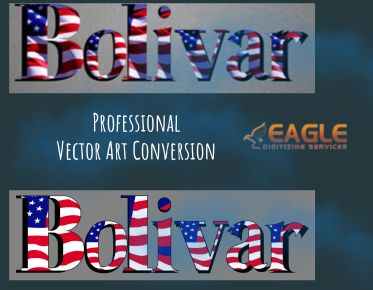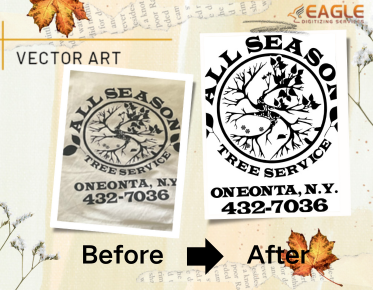From Patterns to Perfection: Using Embroidery Designs on Cloth
When embroidery is done correctly, it enhances the aesthetic appeal of the fabric, adds a personal touch, and showcases craftsmanship. Well-applied designs are durable and can withstand regular use and washing. They also add texture and dimension to fabric, turning simple items into statement pieces that reflect creativity and skill.If this post piqued your curiosity and you wish to learn more about Embroidery Digitizing, feel free to reach out to us.
Choosing the Right Embroidery Design
Picking a Design that Complements the Fabric
The first step in successful embroidery is choosing a design that complements the fabric. Heavier fabrics can support more intricate and dense designs, while lighter fabrics might benefit from simpler, more delicate patterns. Consider the color, texture, and pattern of the fabric to ensure the design enhances rather than overwhelms it.
Considering the Purpose and Placement
Think about where and how the embroidered item will be used. Designs for frequently washed items, like tablecloths or children's clothing, should be robust and not overly intricate. Placement is also key; designs on sleeves, collars, or near seams require careful consideration to avoid discomfort and ensure the design stands out.
Balancing Complexity and Simplicity
A balance between complexity and simplicity can make or break your embroidery project. Overly complex designs on unsuitable fabrics can lead to frustration and subpar results. Simple designs, well-executed, often have the most impact. Striking a balance that matches your skill level and the fabric’s capabilities is crucial.
Preparing Your Fabric
Washing and Ironing the Fabric Before Embroidery
Preparing your fabric involves washing and ironing it to eliminate any shrinkage and wrinkles that could distort your design. Pre-washing also helps remove any chemicals or sizing agents that might interfere with the embroidery process.
Stabilizing the Fabric: Why It’s Important
Stabilizing the fabric is a crucial step that provides support and prevents puckering and distortion. Stabilizers come in various types and can be ironed on, sewn in, or even washed away after the embroidery is complete.
Choosing the Right Stabilizer for Your Fabric
The fabric and pattern determine the type of stabilizer used. For light fabrics, a tear-away stabilizer may suffice, while heavier fabrics or more intricate designs might require a cut-away stabilizer. Water-soluble stabilizers are ideal for sheer fabrics or when the stabilizer needs to be completely removed.
Setting Up Your Workspace
Organizing Your Tools and Materials
A well-organized workspace can significantly improve your efficiency and enjoyment of the embroidery process. Keep your threads, needles, hoops, and other tools neatly arranged and within easy reach.
Ensuring Proper Lighting and Ergonomics
Good lighting is essential for detailed work like embroidery. Natural light is best, but if that’s not possible, use a bright, adjustable lamp. Ensure your workspace is ergonomically set up to avoid strain; your chair should support good posture, and your work surface should be at a comfortable height.
Keeping Your Workspace Clean and Tidy
A clean workspace minimizes distractions and prevents mistakes. Regularly clean your area of thread scraps, dust, and other debris. This practice helps maintain the integrity of your embroidery and keeps your materials in good condition.
Transferring the Design
Different Methods to Transfer Embroidery Designs
There are several methods to transfer your design onto fabric, including using transfer paper, light boxes, or even freehand drawing. Each method has its pros and cons, so choose one that suits your project and personal preference.
Using Transfer Paper for Accurate Results
Transfer paper is a popular choice for its accuracy and ease of use. Simply trace your design onto the transfer paper, place it on your fabric, and apply heat with an iron. The design will transfer clearly, providing a precise guide for your embroidery.
Freehand Drawing vs. Pre-made Stencils
Freehand drawing allows for greater creativity and flexibility, though it requires a steady hand and confidence. Pre-made stencils, on the other hand, offer precision and are particularly useful for repetitive patterns or intricate designs.
Hooping the Fabric
Choosing the Right Embroidery Hoop
The right hoop is essential for maintaining fabric tension. Hoops come in various sizes and materials; wooden hoops are traditional and sturdy, while plastic hoops are lightweight and often easier to adjust.
Properly Hooping the Fabric for Best Results
To hoop the fabric properly, place the inner hoop under the fabric and the outer hoop on top. Tighten the screw while gently pulling the fabric taut. The fabric should be drum-tight but not stretched to the point of distortion.
Adjusting Hoop Tension to Avoid Fabric Distortion
Adjusting the tension of the hoop is crucial to avoid distorting the fabric. The fabric should be tight enough to prevent shifting but loose enough to avoid stretching. Regularly check and adjust the tension as you work.
Thread Selection and Preparation
Choosing the Right Thread Type for Your Fabric
Threads come in various materials, including cotton, silk, and polyester. The choice of thread should complement the fabric; for example, silk threads are ideal for delicate fabrics, while polyester threads are strong and versatile.
Matching Thread Colors to Your Design
Color selection is vital for a cohesive design. Choose colors that complement the fabric and each other. Using a color wheel can help in selecting harmonious colors and achieving a balanced look.
Prepping Your Thread: Avoiding Knots and Tangles
Preparing your thread properly can prevent knots and tangles. Cut a manageable length of thread, usually about 18 inches. Run it through a thread conditioner to reduce static and fraying, and avoid doubling the thread unless necessary for the design.
Stitching Techniques
Basic Stitch Types for Beginners
Beginners should start with basic stitches like the running stitch, backstitch, and satin stitch. These foundational stitches are versatile and form the basis for more complex techniques.
Advanced Stitching Techniques for Intricate Designs
For more intricate designs, advanced stitches like the French knot, bullion stitch, and turkey work add texture and detail. These stitches require practice but significantly enhance the depth and complexity of your work.
Combining Stitch Types for Unique Effects
Combining different stitch types can create unique effects and add visual interest. Experiment with layering stitches and varying thread thicknesses to achieve a dynamic and textured look.
Maintaining Tension and Consistency
Tips for Keeping Stitch Tension Consistent
Consistent tension is key to a polished embroidery piece. Keep your stitches uniform by maintaining even thread tension and spacing. Regularly check your work and adjust your technique as needed.
Avoiding Common Tension Problems
Common tension problems include loose stitches, puckering, and uneven lines. To avoid these, ensure your fabric is properly hooped, use appropriate thread lengths, and maintain a steady stitching rhythm.
How to Fix Tension Issues on the Go
If you encounter tension issues mid-project, don’t panic. Carefully remove the affected stitches and re-stitch the area. Adjust your hoop or thread tension as needed to prevent recurrence.
Embroidering on Different Fabrics
Tips for Embroidering on Cotton and Linen
Cotton and linen are relatively easy to embroider. Use a medium-weight stabilizer and ensure your stitches are even. These fabrics are forgiving, making them ideal for beginners.
Techniques for Silk and Satin Embroidery
Silk and satin require delicate handling. Use a sharp needle and a lightweight stabilizer to avoid damaging the fabric. Keep your stitches loose to prevent puckering and maintain the fabric’s natural drape.
Handling Stretch Fabrics Like Jerseys and Knits
Stretch fabrics like jerseys and knits can be challenging. Use a stretch stabilizer and hoop the fabric gently to avoid stretching it out of shape. Consider using a ballpoint needle to prevent snagging.
Adding Personal Touches
Customizing Designs with Initials and Names
Adding initials and names personalizes your embroidery. Use a contrasting thread color for visibility and choose a font that complements the design. Monograms add a touch of elegance to any project.
Incorporating Decorative Elements
Incorporating decorative elements like borders, flourishes, and motifs can enhance your design. Use complementary colors and stitches to integrate these elements seamlessly.
Using Beads and Sequins for Extra Flair
Beads and sequins add sparkle and texture. Secure them firmly with small stitches and use them sparingly to avoid overwhelming the design. These embellishments can turn a simple piece into a showstopper.
Embroidering on Garments
Positioning Designs on Shirts, Dresses, and More
Positioning your design correctly on garments is crucial. For shirts, place designs on the chest or sleeve. For dresses, consider the hemline or neckline. Ensure the design is centered and symmetrical.
Embroidering on Sleeves, Collars, and Cuffs
Embroidery on sleeves, collars, and cuffs requires precision. Use smaller hoops for these areas and ensure the design complements the garment’s structure. This adds a refined and bespoke touch to your clothing.
Ensuring Durability of Embroidered Garments
To ensure durability, use strong threads and secure your stitches well. Reinforce high-stress areas and consider using a backing fabric for additional support. Proper finishing techniques also contribute to longevity.
Avoiding Common Mistakes
Top Embroidery Mistakes and How to Avoid Them
Common mistakes include improper hooping, poor thread choice, and inconsistent tension. To avoid these, take your time with each step, choose quality materials, and practice regularly.
Recognizing and Correcting Errors Mid-Project
Recognizing errors early can save you time and frustration. Regularly inspect your work for mistakes and correct them immediately. Use a seam ripper to carefully remove flawed stitches and rework the area.
Tips for a Smooth and Flawless Finish
A smooth and flawless finish requires patience and attention to detail. Trim loose threads, clean up your workspace, and press your work to remove wrinkles. These small steps make a big difference in the final product.
Finishing Your Embroidery
Trimming and Cleaning Up Loose Threads
Trimming loose threads gives your embroidery a neat appearance. Use sharp scissors to carefully snip threads close to the fabric. This prevents fraying and maintains a tidy look.
Removing Stabilizer Without Damaging the Fabric
Remove the stabilizer gently to avoid damaging the fabric. Tear-away stabilizers can be carefully pulled away, while water-soluble stabilizers dissolve in water. Follow the manufacturer’s instructions for the best results.
Pressing Your Embroidery for a Polished Look
Pressing your embroidery gives it a polished finish. Use a pressing cloth to protect the stitches and press from the back of the fabric. This flattens the stitches and enhances the overall appearance.
Caring for Embroidered Items
Washing and Drying Embroidered Fabrics
Wash embroidered items gently to preserve the stitches. Use mild detergent and cool water, and avoid wringing the fabric. Lay flat to dry or use the dryer's low-heat setting.
Storing Embroidered Items to Prevent Damage
Store embroidered items carefully to prevent damage. Avoid folding them in ways that crease the embroidery. Use acid-free tissue paper and keep it in a cold, dry area.
Repairing and Touching Up Embroidery Over Time
Over time, embroidery may need repairs. Reinforce loose stitches, replace missing beads, and touch up faded areas. Regular maintenance keeps your work looking fresh and vibrant. Eagle Digitizing offers embroidery digitizing services.
Successfully using embroidery designs involves choosing the right design, preparing your fabric, and executing the stitches with precision. Each step is crucial for achieving high-quality results.
Mastering embroidery requires patience, creativity, and dedication. By following best practices and continually refining your skills, you can create beautiful, lasting pieces that reflect your unique artistic vision.



